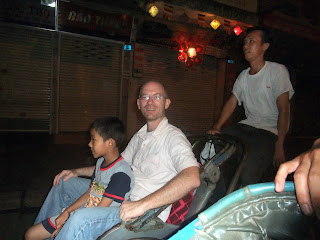
Our most memorable and special experience on our previous trip to Vietnam was going to Hoi An with our friend who is a native there to visit her family, and we've been looking forward to a return visit on this trip. The best part is breaking bread with locals and getting to experience life off the tourist trail. This time we were invited to tag along on a family expedition -- 15 people total in a rented van -- to visit relations in the countryside, tour some caves, hitting the historic sites in Hue and than return for a full day in Hoi An.
We ran into some bad luck, though, and had to let the group go ahead of us from Hoi An for a couple days while Ilene rode out a case of food poisoning. We missed the country cousins and the caves and took a bus to catch up with the rest in Hue on the third night.
Hue was the capital of the country during the 19th and early 20th centuries, and the citadel of the royal forbidden city and a lot of the royal tombs still remain along the Perfume River in the city center and in the surrounding countryside. We spent a full day touring those with our friend's family, as well as hitting some of the famous local cuisine and the market to buy souvenirs like tea and chili paste.
Then it was back to Hoi An for our last night. Hoi An is a small city on the coast that at one point was an international trading port until the river silted over, and the old town still shows traces of the Japanese and Chinese influence there. In the morning our friend organized an odd little boat excursion around the island near the old town. It was on a tiny skiff that seated the four of us and the ferryman. When we first got in, we were being paddled by a toothless old man and after awhile we came across another boat being paddled by his brother, who was missing a leg. They traded places because the one-legged brother, about 5' 4" and 80 years old, was the stronger paddler. Ilene and I couldn't take the guilt and took up paddles ourselves and tried to get us around the island a little quicker, but it was still a solid hour of work.
The main reasons we returned to Hoi An were to enjoy our favorite local dishes and to go to the beach. It was my only day at the beach in 6 months despite traipsing all over southeast Asia within spitting distance of the Indian Ocean and the South China Sea. Two years ago when we came here we went to the main town beach, well-known to tourists, and our friend also took us to another beach where we were the only foreigners. Since then, word has gotten out and there are plenty of tourists there now. There's plenty of room for everybody, but it was nice to have the bragging rights before.
The other thing that has changed in two years is a serious erosion in infrastructure -- both metaphorically and literally. The monsoon season last year brought disastrous flooding to Hoi An, and the streets are still unusable messes in some places. Electric supply also seems to be falling further behind demand. Our experience -- four power cuts in three days -- may be just chance, but we do hear anecdotally that this is becoming more common throughout the country. It's pretty disheartening to come back from a hot day seeing the sites, planning to lay down in front of a fan, and to see that the hotel lobby is dark again.
As before, the best part of the trip was spending time with our friend's family. She has the most photogenic nieces and nephews in the world, and her sisters and sister-in-law are fantastic cooks. They put on a couple of delicious spreads for us. You gotta love it when you hear a chicken clucking in the kitchen on your way out to the beach and then find a chicken dinner waiting for you when you get back.
-
Robert


 This isn't my first post about che (pronounced jay-uh), but there seem to be more kinds than I'll ever have a chance to try. Some are almost as firm as cakes, most are like a tapioca pudding, and my favorites are more like watery beverages and very refreshing like a sweetened iced tea. On English-language menus, it's often called "sweet soup," served either warm or chilled, and the one pictured here looks at a glance like lentil soup when it is ladled out. It's made with different kinds of sweetened green or red beans, cooked in a kettle over a charcoal brazier, poured over ice and has coconut shavings on top, garnished with a shake of oil from banana leaves. It costs about 25 cents and the shade of the ancient banyan tree is thrown in for free.
This isn't my first post about che (pronounced jay-uh), but there seem to be more kinds than I'll ever have a chance to try. Some are almost as firm as cakes, most are like a tapioca pudding, and my favorites are more like watery beverages and very refreshing like a sweetened iced tea. On English-language menus, it's often called "sweet soup," served either warm or chilled, and the one pictured here looks at a glance like lentil soup when it is ladled out. It's made with different kinds of sweetened green or red beans, cooked in a kettle over a charcoal brazier, poured over ice and has coconut shavings on top, garnished with a shake of oil from banana leaves. It costs about 25 cents and the shade of the ancient banyan tree is thrown in for free.















